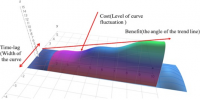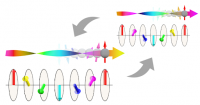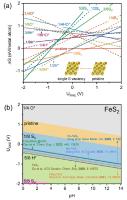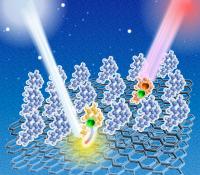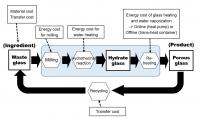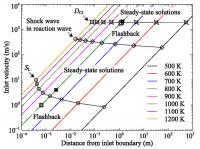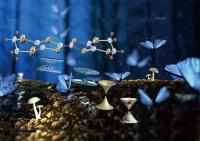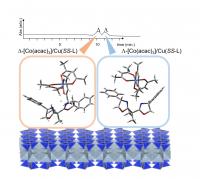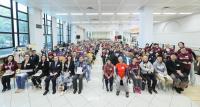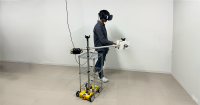Content is provided by our community of institutions, partners, researchers and journalists.
Daegu Gyeongbuk Institute of Science and Technology (DGIST)
24 Mar 2024
- Expectations to build a superior domestic and international research network through research excellence, leading global interdisciplinary research and enhancing global research capabilities.
Daegu Gyeongbuk Institute of Science and Technology (DGIST)
24 Mar 2024
- Prof. Sang Hyun Park of the Department of Robotics and Mechatronics Engineering has developed a logical anomaly detection technology that utilizes segmentation results through artificial intelligence (AI).
- The research results were published by the Association for the Advancement of Artificial Intelligence (AAAI), the premier AI conference, in February 2024.
Daegu Gyeongbuk Institute of Science and Technology (DGIST)
24 Mar 2024
- DGIST startup company “SeaWith” recognized for its excellence in seaweed cultured meat production technology
Daegu Gyeongbuk Institute of Science and Technology (DGIST)
24 Mar 2024
- DGIST Prof. Hyuk-Jun Kwon's team has developed neuromorphic devices using ferroelectrics and two-dimensional channels.
- Similar to the human brain, they perform both computational and memory functions –– but 10,000 times faster than synapses with minimal energy consumption.
- Their application to next-generation AI semiconductor technology is anticipated.
Daegu Gyeongbuk Institute of Science and Technology (DGIST)
24 Mar 2024
- A team led by DGIST Professor Jeongho Kwak proposes VisionScaling algorithm, enhancing user experience in 6G vision services while conserving energy in mobile devices
- Efficient technology development anticipated to enhance user experience in various vision services of the upcoming 6G era (AR/XR, autonomous driving, etc.)
Daegu Gyeongbuk Institute of Science and Technology (DGIST)
24 Mar 2024
Revelation of the molecular code for constructing brain neural circuits
With identification of the characteristics of excitatory synapses and memory cognition regulation mechanisms mediated by synaptic gene microexons
- A research team led by DGIST Prof. Jaewon Ko has unearthed the microexon molecular code for the formation of synaptic signal patterns through the synaptic adhesion protein LAR-RPTP.
- This finding is expected to provide crucial clues for the development of new brain disease treatments targeting protein complexes.
Daegu Gyeongbuk Institute of Science and Technology (DGIST)
24 Mar 2024
- Presents eight models of micro-open innovation dynamics, suggesting strategies for corporate open innovation
- Published in the Technological Forecasting and Social Change (TFSC) journal, among the top 1% in the global innovation economy field
Daegu Gyeongbuk Institute of Science and Technology (DGIST)
24 Mar 2024
- Development of 'Inorganic-Organic Thermoelectric Composite' from Low-Temperature Inorganic Thermoelectric Materials and Conductive Polymers, Ensuring Efficiency and Flexibility
- Research findings published in ACS Applied Materials & Interfaces
Tohoku University
22 Mar 2024
A team of researchers has proposed a new concept for magnet-based memory devices, which might revolutionize information storage devices owing to their potential for large-scale integration, non-volatility, and high durability.
Tohoku University
22 Mar 2024
The means to synthesize ammonia from nitrogen and hydrogen gas has been around since the early 20th century. Despite its current widespread usage, it has significant environmental drawbacks. Now, researchers from Tohoku University have unveiled a new, environmentally friendly means of producing this widely used chemical.
Duke-NUS Medical School
21 Mar 2024
Scientists from Duke-NUS Medical School have identified a gene that plays a crucial role in regulating energy supply to cells that drive kidney failure. This discovery concerning the gene, named WWP2, offers a new target for therapies aimed at mitigating kidney scarring and damage.
21 Mar 2024
At least one in a dozen stars show evidence of planetary ingestion according to a paper published in Nature today.
Hokkaido University
21 Mar 2024
Cellulose, abundantly available from plant biomass, can be converted into molecules used to make a new class of recyclable polymers, to sustainably replace some plastics.
MAP Academy
19 Mar 2024
In the late 1930s, French archaeologists discovered a large and remarkable group of ivory sculptures, in Afghanistan's Begram (present-day Bagram). Stipulated to have been used as accents or embellishments for wooden furniture, these carved objects showcase a blend of Greco-Roman, Central Asian, Mediterranean, and Indic stylistic influences. Despite the political upheavals in the region, some of these ivory artefacts still survive. Explore how ongoing scholarly efforts shed light on the historical significance of these art objects, highlighting the cultural connections that were built and flourished along the Silk Road.
Osaka Metropolitan University
19 Mar 2024
Understanding electron behavior and surface structure of triphenylene thin film molecules deposited on graphite substrates under light irradiation
Osaka University
19 Mar 2024
Researchers from Osaka University conducted a series of participatory deliberation workshops at Osaka University in which the participants were asked to consider issues of future society and manufacturing, in general, and as they relate to hydrothermally produced porous glass. In workshops where the perspective of “imaginary future generations” was adopted, participants’ perceptions of the technology’s feasibility and future potentiality changed significantly.
Newcastle University in Singapore
19 Mar 2024
The 12th Starch Value Chain ASIA conference was held in Vientiane, at Crowne Plaza Hotel, from February 27 to 29, 2024. The conference encompassed four key themes: Asia’s starch markets, industrial and food-grade tapioca starch in Laos with expansion plans, sustainable climate-smart agri-technology for rice and cassava cultivation, and challenges for future growth in Asia's biogas-to-energy sector.
Osaka University
18 Mar 2024
Researchers from Osaka University developed a system that enables projection mapping within an illuminated environment. Several standard projectors and one large-aperture projector reproduce the environmental illumination in all areas except for the target object, whereas texture projectors display the texture on the unilluminated object’s surface. Experiments show that participants perceived the objects using surface-color mode instead of aperture-color mode, verifying that the proposed system has the potential to produce highly realistic interactive environments.
Osaka Metropolitan University
18 Mar 2024
Two rare skin conditions with similar symptoms can be mistaken for each other, so a scoring system has been formulated to aid physicians in distinguishing two diseases
Academia Sinica
18 Mar 2024
Amyotrophic Lateral Sclerosis (ALS) and Frontotemporal Dementia (FTD) are neurodegenerative diseases that commonly occur in middle-aged people. FTD is second only to Alzheimer's disease in terms of dementia prevalence. Both ALS and FTD arise from neuronal degeneration through mechanisms that remain unclear. Dr. Yun-Ru (Ruby) Chen's team in the Genomics Research Center (GRC), Academia Sinica recently discovered a new pathological mechanism for neuronal degeneration using synthetic peptides. They also discovered that a disaccharide can increase neuronal survival and reduce degeneration. The result provides therapeutic strategies for future treatment of these neurodegenerative diseases. The study was published in the top international journal "Science Advances" on February 23, 2024.
Hokkaido University
15 Mar 2024
Acoustic recordings of a colony of little auks reveal their nocturnal activities and offer valuable monitoring means for avian biology in the Arctic.
Asia Research News
15 Mar 2024
Asia Research News monitors the latest research news in Asia. Some highlights that caught our attention this week are what happens in our brains when we interact with dogs, our brain and eye activity when we focus on something, and how many children is the ‘ideal’ amount.
Lingnan University (LU)
15 Mar 2024
Lingnan University has launched a three-day (13-15 March) career expo, titled "Resurgence Career Expo@LingnanU 2024" on campus, drawing the participation of more than 100 companies offering over a thousand of job opportunities for Lingnanians. The first two days of the physical event attracted over a thousand Lingnan University students and alumni to participate. This marks the University’s first large-scale career expo since the COVID-19 pandemic. The aim of the event is to provide a platform for employers to engage with Lingnan students, introducing their companies, and jobs. This will allow students who are about to graduate to gain first-hand information about the job market and equip themselves for future career endeavours. Lingnan University also extends a warm welcome to alumni, encouraging them to return to campus and explore development opportunities across various industries. In addition to the physical career fair, Lingnan University is concurrently holding the "Resurgence Career Expo@LingnanU 2024" in hybrid mode. The online platform will remain accessible until the end of April, providing additional time for Lingnan students and graduates to explore job search strategies and pursue their desired careers.
Tohoku University
15 Mar 2024
Researchers from Tohoku University have theoretically linked ignition and deflagration in a combustion system, unlocking new configurations for stable, efficient combustion engines due to the possible existence of any number of steady-state solutions.
Ehime University
15 Mar 2024
The “scope of action” and the velocity of Dirac electrons in an organic material
Ehime University
15 Mar 2024
A packing material has been developed for chromatographic resolution on the basis of a clay mineral. The material is an adduct of chiral Cu(II) complex and synthetic hectorite.
Asia Research News
14 Mar 2024
Ancient Mars biomolecules, Gargling away bad bacteria, Molecule glasses magnify life-chemical observations, Cholesterol and cancer link, Quantum electronics leap, Plus our updated Experts for Media: Women list & Asia Research News 2024 is here. Read all in the latest Editor's Choice.
Lingnan University (LU)
14 Mar 2024
"LU Jockey Club Health and Financial Education Programme for Elderly", organised by Institute of Policy Studies of Lingnan University and funded by The Hong Kong Jockey Club Charities Trust, was awarded the IFEA (Teaching – School Division) Silver Award by Investor and Financial Education Council (IFEC), making it the only university in Hong Kong to be selected as one of the top three winners. The respective Assessment Committees are comprised of government representatives, IFEC Board members, and industry experts, recognising Lingnan University’s efforts to advance investor and financial education by improving the elderly’s health and financial literacy, and sharing best practices in investor and financial education projects. The Honourable Mr Paul Chan Mo-po, GBM, GBS, MH, JP, Financial Secretary of the HKSAR Government, presented an award to Lingnan University representative, Vice-President Prof Joshua Mok Ka-ho yesterday (13 March).
Singapore University of Technology and Design
13 Mar 2024
Inspired by beetle cuticles, SUTD and NUS scientists have developed optical structures that can produce vibrant, iridescent and completely biodegradable colours using chitin – the world's second most abundant organic material.
Tohoku University
13 Mar 2024
Recreating the action of opening doors in the virtual world requires engineering ways in which to provide the equivalent haptic feedback and steer users away from walls in the real world. A research group has done just this; developing RedirectedDoors+, which employs door robots and rotation to create a more realistic experience.







